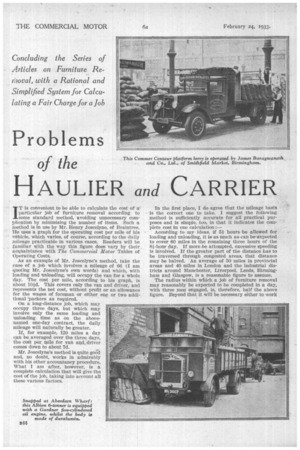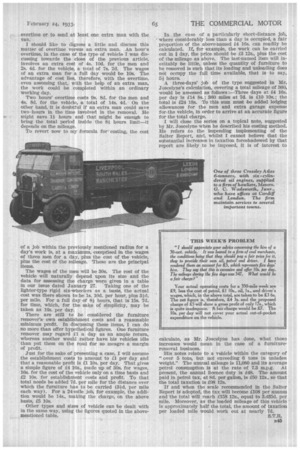Problems
Page 58

Page 59

If you've noticed an error in this article please click here to report it so we can fix it.
of the
HAULIER and CARRIER IT is convenient to be able to caktdate the cost of a particular job of furniture removal according to some standard method, avoiding unnecessary complication by minimizing the number of items. Such a method is in use by Mr. Henry Joscelyne, of Braintree. He uses a graph for the operating cost per mile of his Tehicle, which varies, of course, according to the daily mileage practicable in various cases. Readers will be familiar with the way this figure does vary by their. acquaintance with The Commercial Motor Tables of Operating Costs.
As an example of Mr. Joscelyne's method, take the ease of a job which involves a mileage of 66 (I am quoting Mr. Joscelyne's own words) and which, with
loading and unloading, will occupy the van for a whole day. The cast per mile, according to his graph, is about 10id. This covers only the van and driver, and represents the net cost, without profit or an allowance for the wages of foreman or either one or two additional packers as required.
On a long-distance job, which may occupy three days, but which may involve only the same loading and unloading time as on the abovenamed one-day contract, the daily mileage will naturally be greater.
If, for example, 120 miles a day can be averaged over the three days, the cost per mile for van and driver comes dawn to about 7d.
Mr. Joseelyne's method is quite gogd and, no doubt, works in admirably with his other accountancy procedure. What I am after, however, is a complete calculation that will give the cost of the job, taking into account all these various factors.
In the first place, I do agree that the mileage basis is the correct one to take. I suggest the following method is sufficiently accurate for all practical purposes and is simple, too, in that it indicates the complete cost in one calculation:—
According to my ideas, it 51 hours he allowed for loading and unloading, it is as much as can be expected to cover 60 miles in the remaining three hours of the 8i-hour day. If more be attempted, excessive speeding is involved. If the greater part of the distance has to be traversed through congested areas, that distance may be halved. An average of 50 miles in provincial areas and 40 miles in London and the industrial districts around Manchester, Liverpool, Leeds, Birmingham and Glasgow, is a reasonable figure to assume.
The radius within which a job of furniture removal may reasonably be expected to he completed In a day, with three men engaged, is, therefore, half the above figure. Beyond that it will be necessary either to work overtime or to send at least one extra man with the van:
I should like to digress a little and discuss this matter of overtime versus an extra man. An hour's overtime, in the case of the type of vehicle I was discussing towards the close of the previous article, involves an extra cost of 4s. 10d. for the men and 2s. 4d. for the vehicle, a total of 7s. 2d. The wages of an extra man for a full day would be 10s. The advantage of cost lies, therefore, with the overtime, even assuming that, with the help of an extra man, the work could be completed within an ordinary working day.
Two hours' overtime costs 9s. 8d. for the men and 4s. 8d. for the vehicle, a total of 14s. 4d. On the other hand, -it is doubtful if an extra man could save two hours in the time involved in the removal. He might save 1/ hours and that might be enough to bring the total period inside the 8i hours limit-it depends on the mileage.
To revert now to my formula for' costing, the cost of a job within the previously mentioned radius for a day's work is, at a maximum, comprised in the wages of three men for a day, plus the coat of the vehicle, plus the cost of the mileage. Those are the principal items.
The wages of the men will be 308. The cost of the vehicle will naturally depend upon its size and the data for assessing the charge were given in a table in our issue dated January 27. Taking one of the lighter-type rigid six-wheelers as a basis, the actual cost was there shown to be is. 10d, per hour, plus 31-d. per mile. For a full day of 8-i hours, that is 15s. 7d. for time, which, for the sake of simplicity, may be taken as 16s. per day.
There are still to be considered the furniture • remover's own establishment costs and a reasonable minimum profit. In discussing these items, I can do no more than offer hypothetical figures. One furniture remover may regard £1 a day as an ample return, whereas another would rather have his vehicles idle than put them on the road for so meagre a margin of profit.
Just for the sake of presenting a case, I will assume the establishment cost.s to amount to II per day and that a reasonable profit is £1 10s. per day. That gives a simple figure of £4 16s., made up of 30s. for wages, 36s. for the cost of the vehicle only on a time basis and £2 10s. for establishment costs and profit. To that total needs be added 7d. per mile for the distance over which the furniture has to be carried (3i-d. per mile each way). For a 24-mile job, for example, the addition would be 14s., making the charge, on the above basis, £5 10s.
Other types and sizes of vehicle can be dealt with in the same way, using the figures quoted in the abovementioned table.
In the case of a particularly short-distance job, where considerably less than a day is occupied, a fair proportion of the above-named £4 16s. can readily be calculated, If, for example, the work can be carried out in day, the price should be a 12s., plus the cost of the mileage as above. The last-named item will inevitably be little, unless the quantity of furniture to be removed is such that its loading and unloading does not occupy the full time available, that is to say, 5q hours.
A three-days' job of the type suggested in Mr. Joscelyne's calculation, covering a total mileage of 360, would be assessed as follows :---Three days at £4 16s. per day is £14 8s.; 360 miles at 7d. is £10 10s.; the total is £24 18s. To this sum must be added lodging allowances for the men and extra garage expense for-the vehicle, in order to arrive at an accurate figure for the total charge.
I will close the series on a topical note, suggested by Mr. Joscelyne when he described his costing method. He refers to the impending implementing of the Salter Report, and, whilst I cannot believe that the substantial increases in taxation foreshadowed by that report are likely to be imposed, it is of interest to
calculate, as Mr. Joseelyne has done, what those increases would mean in the case of a furnitureremoval business.
His notes relate to a vehicle within the category of "over 5 tons, but not exceeding 6 tons in unladen weight." The annual mileage is 11,080 and its average petrol consumption is at the rate of 7.3 m.p.g. At present, the annual licence duty is £48. The amount paid in petrol tax, at 8d. per gallon, is £50 12s., so that the total taxation is £98 12s.
If and when the scale recommended in the Salter Report is adopted, the tax will become £108 per annum and the total will reach £158 12s., equal to 3.435d. per mile. Moreover, as the loaded mileage of this vehicle is approximately half the total, the amount of taxation per loaded mile would work out at nearly 7d. S.T.R. n45




























































































